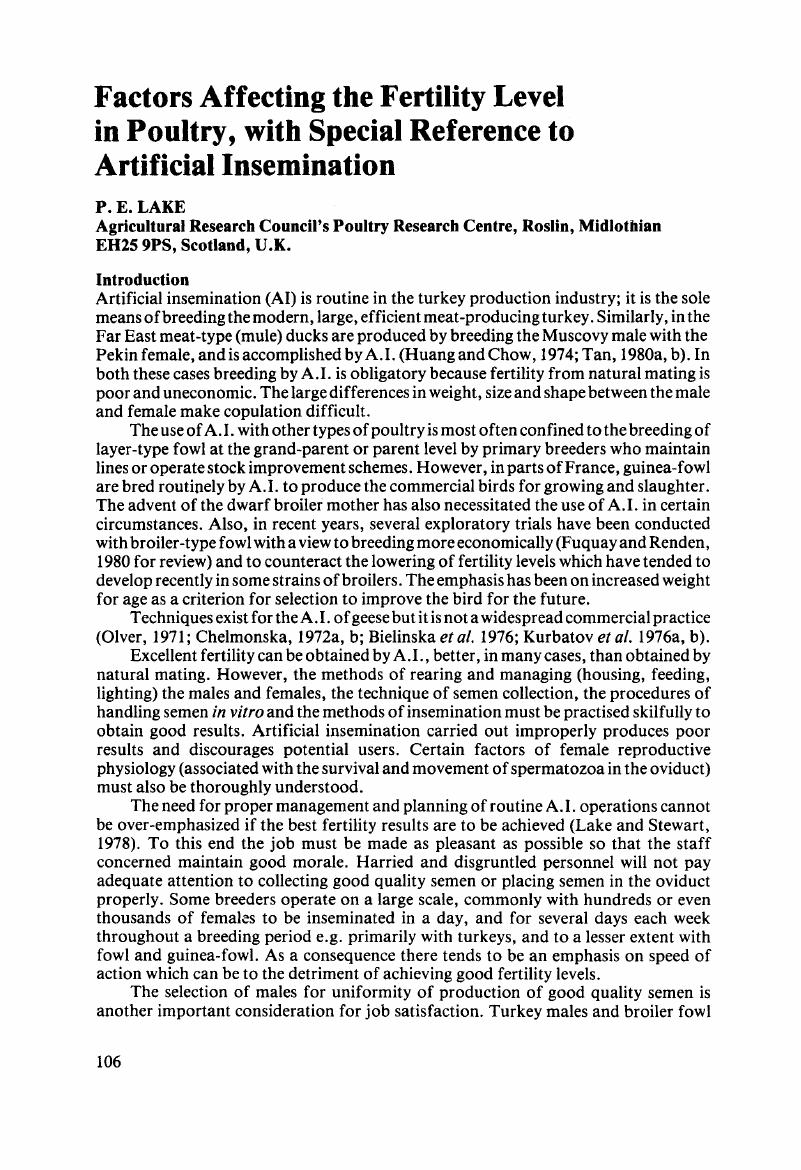Crossref Citations
This article has been cited by the following publications. This list is generated based on data provided by Crossref.
Van Wambeke, F.
1984.
Effect of semen storage time and number of spermatozoa inseminated on the fertility and hatchability of eggs from dwarf broiler breeder hens.
British Poultry Science,
Vol. 25,
Issue. 4,
p.
583.
McINTYRE, D.R.
and
CHRISTENSEN, V.L.
1985.
Effect of Initial Insemination and Insemination Interval on Fertility in Turkey Hens.
Poultry Science,
Vol. 64,
Issue. 8,
p.
1549.
Johnson, A. L.
1986.
Avian Physiology.
p.
432.
Sexton, T. J.
1986.
Relationship of the number of spermatozoa inseminated to fertility of Turkey semen stored 6 h at 5°c.
British Poultry Science,
Vol. 27,
Issue. 2,
p.
237.
Bilgili, S. F.
1989.
Current and future role of artificial insemination in the broiler industry.
British Poultry Science,
Vol. 30,
Issue. 2,
p.
455.
Bratte, L.
and
Ibe, S.N.
1989.
Optimal insemination interval, semen dose and dilution for optimum fertility in chickens under humid tropical conditions.
Animal Reproduction Science,
Vol. 20,
Issue. 3,
p.
179.
DONOGHUE, ANN M.
GARNER, DUANE L.
DONOGHUE, DAN J.
and
JOHNSON, LAWRENCE A.
1995.
Viability Assessment of Turkey Sperm Using Fluorescent Staining and Flow Cytometry.
Poultry Science,
Vol. 74,
Issue. 7,
p.
1191.
Donoghue, A.M.
Garner, D.L.
Donoghue, D.J.
and
Johnson, L.A.
1996.
Assessment of the membrane integrity of fresh and stored turkey spermatozoa using a combination of hypo-osmotic stress fluorescent staining and flow cytometry.
Theriogenology,
Vol. 46,
Issue. 1,
p.
153.
DONOGHUE, ANN M.
1996.
The Effect of Twenty-Four Hour In Vitro Storage on Sperm Hydrolysis Through the Perivitelline Layer of Ovipositioned Turkey Eggs.
Poultry Science,
Vol. 75,
Issue. 8,
p.
1035.
Guojun, Chen
Gee, George F.
Nicolich, Jane M.
and
Taylor, Joanna A.
1998.
Investigation into semen characteristics of naturally-fertile pairs in vitro and their correlation with fertility in Florida Sandhill crane.
Journal of Forestry Research,
Vol. 9,
Issue. 2,
p.
71.
Stunden, CE
Bluhm, CK
Cheng, KM
and
Rajamahendran, R
1998.
Plasma testosterone profiles, semen characteristics, and artificial insemination in yearling and adult captive Mallard ducks (Anas platyrhynchos).
Poultry Science,
Vol. 77,
Issue. 6,
p.
882.
Parker, H.M.
and
McDaniel, C.D.
2002.
Selection of Young Broiler Breeders for Semen Quality Improves Hatchability in an Industry Field Trial.
Journal of Applied Poultry Research,
Vol. 11,
Issue. 3,
p.
250.
Parker, H.M.
Karaca, A.G.
Yeatman, J.B.
Frank, L.R.
and
McDaniel, C.D.
2002.
Fertility of Broiler Breeders Following Categorization by the OptiBreed® Sperm Quality Index When Hens Are Inseminated with a Constant Number of Sperm.
Poultry Science,
Vol. 81,
Issue. 2,
p.
239.
Ameha, Negassi
Moudgal, Ram P.
and
Asmare, Asefa
2007.
Development of Two Stages Cock's Semen Extender for Room Temperature Storage at Laboratory.
The Journal of Poultry Science,
Vol. 44,
Issue. 1,
p.
78.
Siudzińska, A.
and
Łukaszewicz, E.
2008.
Effect of Semen Extenders and Storage Time on Sperm Morphology of Four Chicken Breeds.
Journal of Applied Poultry Research,
Vol. 17,
Issue. 1,
p.
101.
Tabatabaei, S.
2010.
The Effect of Spermatozoa Number on Fertility Rate of Chicken in Artificial Insemination Programs.
Journal of Animal and Veterinary Advances,
Vol. 9,
Issue. 12,
p.
1717.
Mohan, J.
Sharma, S.K.
Kolluri, G.
and
Dhama, K.
2018.
History of artificial insemination in poultry, its components and significance.
World's Poultry Science Journal,
Vol. 74,
Issue. 3,
p.
475.
Roiter, Ya S
and
Konopleva, A P
2019.
Universal biotechnological medium for sperm dilution during poultry artificial insemination.
IOP Conference Series: Earth and Environmental Science,
Vol. 315,
Issue. 4,
p.
042020.
Brown, Megan E.
Keefer, Carol L.
and
Songsasen, Nucharin
2019.
Factors affecting captive whooping crane egg fertility: A retrospective analysis.
The Journal of Wildlife Management,
Vol. 83,
Issue. 6,
p.
1377.
Rakha, B. A.
Ansari, M. S.
Akhter, S.
Akhter, A.
and
Blesbois, E.
2021.
Intravaginal insemination depth influences fertility outcomes in Indian red jungle fowl (Gallus gallus murghi).
Animal Biotechnology,
Vol. 32,
Issue. 4,
p.
526.





